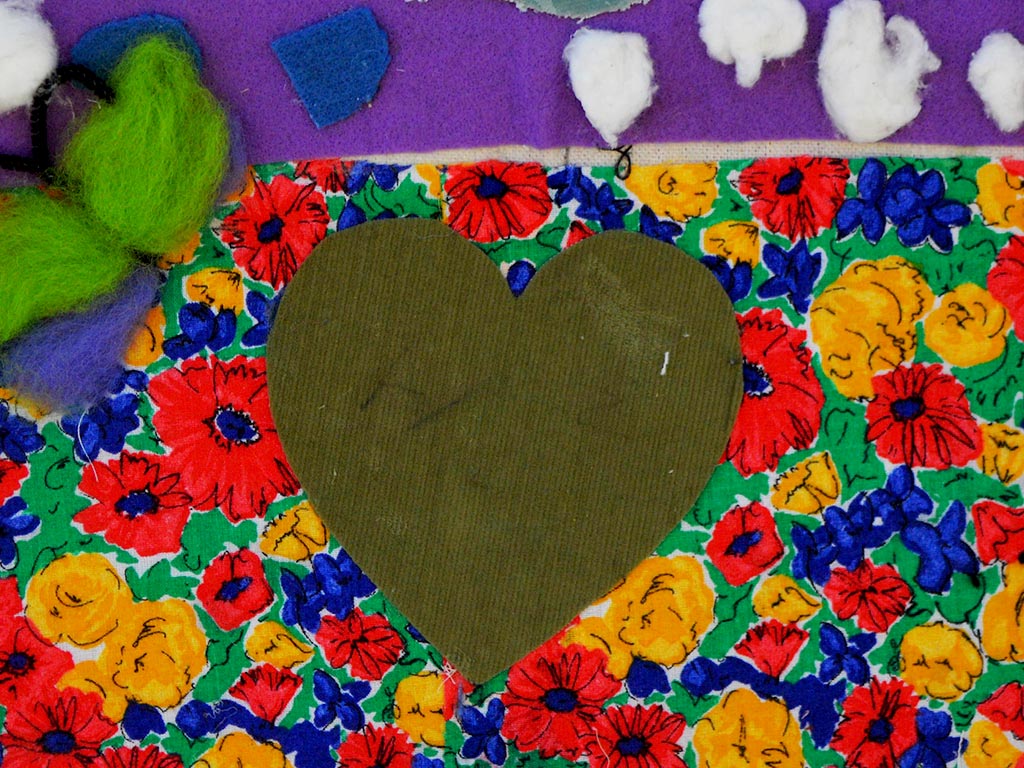Mensajes del Corazón Focus of Student Art Exhibit
March 14, 2016

The UNM Latin American & Iberian Institute is pleased to announce "Mensajes del corazón," an exhibit of arpillera-inspired artwork created by fourth grade students at East San Jose Elementary School in Albuquerque, New Mexico. The exhibit is comprised of nearly 100 textiles expressing the students' concerns and hopes for their community and the broader world. It is on view through May 2016 and is open to the public from 8:00-5:00 p.m., Monday-Friday. An opening reception will be held on Monday, March 21, 2016, from 5:00-7:00 p.m. at the LAII (801 Yale Blvd NE). For reference, please see the exhibit announcement.
Nearly 200 students in the fourth and fifth grades participated in creating the textiles. All of the fourth grade students' projects are on display at the LAII. Students worked under the guidance of art and literacy teacher Amy Sweet to produce them. Over the course of twelve weeks, students studied the history and social context of Chilean arpilleras. They learned about how the textiles were produced by women during the 1970s and '80s as a form of social protest and resistance against the dictatorship of Pinochet. Fourth-grade teachers Ms. Espinosa, Mr. Neu, Ms. Rivera, and Ms. Villareal, as well as fifth-grade teachers Mr. De Maeseneer, Ms. Krishna, Ms. Peña, and Ms. Tapia, also collaborated on the project.
In developing the project, Ms. Sweet drew in part on curriculum about Chilean arpilleras which was produced by the LAII in partnership with the National Hispanic Cultural Center (NHCC), in relation to the NHCC's 2012 exhibit, "Stitching Resistance," which featured an extensive collection of original arpilleras.
As the NHCC wrote at the time of the exhibit, "Arpilleras are a powerful art form. Layers of sackcloth or burlap fabric (arpillera) were joined, principally through appliqué, to create multi-dimensional (in layers and meaning) works of protest and resistance. Arpillera, the burlap cloth, became the preferred medium for resistance and protest because the material was easily obtained and inexpensive. Appliqué, embroidery, and patchwork were traditional skills of women (the widows and mothers) whose families were destroyed in the months and years following the golpe de estado of September 11, 1973. Their artistry with humble cloth is vibrant testimony: history in textile form, every bit as compelling as any other of the visual media. The detail and composition of the works can be simple or intricate. Each one tells a story; each one conveys a message. Visual (and visible) courage and resistance in the guise of "simple and quaint" women's work, arpilleras made in Chile between 1973 and 1990 were masterful and significant as non-violent expressions of denunciation, outrage, and opposition. Post-1990 works show the continuing importance of stitching memory and history into humble cloth scraps. As significant as the works themselves are the artists who created them. Gathering in church basements, soup kitchens, community centers, and workshops the arpilleristas gained momentum as a movement during these crucial years in the history of Chile. Together the women not only created noteworthy works of art, they stitched together a community torn to pieces by violence; they gathered strength to defy, protest, and denounce. With each stitch they grew more vocal and more resilient."
The students at East San Jose Elementary School learned about this history and more. Their artwork became the means by which they expressed their own concerns and hopes for the world, touching on themes such as the dangers of texting while driving, police violence, animal welfare, and immigration policies, among others. The LAII is pleased to partner with the school in order to exhibit these "Mensajes del corazón" and to acknowledge the students' tremendous creativity and thoughtfulness.
The LAII is pleased to partner with East San Jose Elementary School to produce this exhibit. A National Resource Center (NRC) for Latin America, the LAII is deeply committed to expanding awareness and understanding of Latin America among K-12 teachers and students. Moreover, it prioritizes programming that empowers teachers and students and incorporates their knowledge into the classroom - an approach which is nowhere better expressed than through the work of the teachers and students who contributed to the exhibit.
